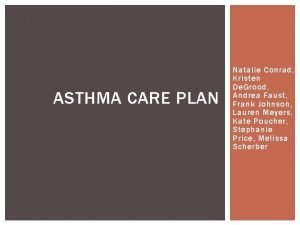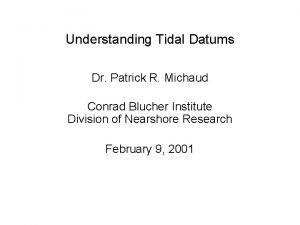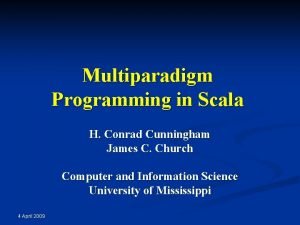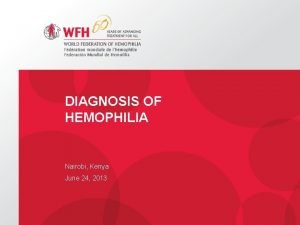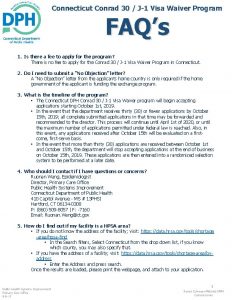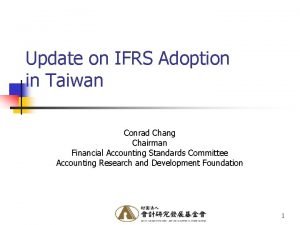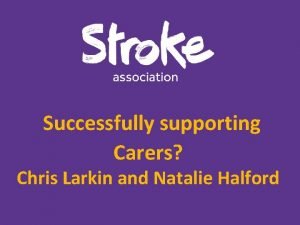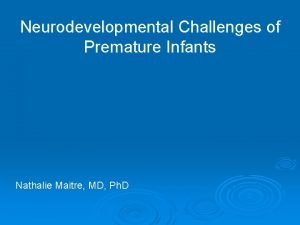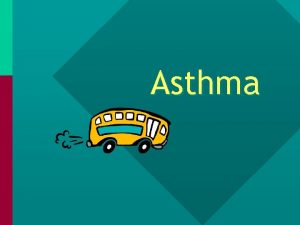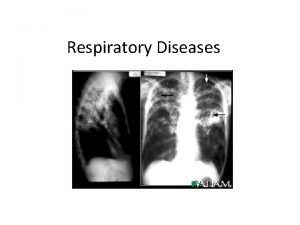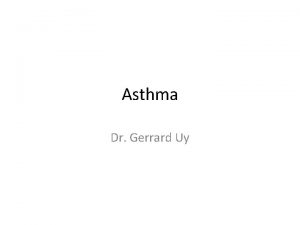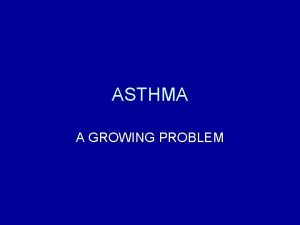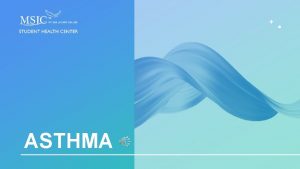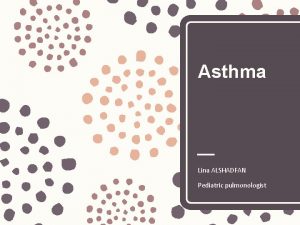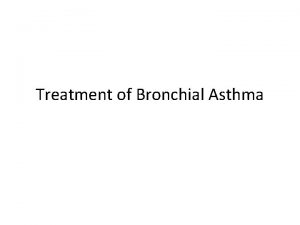ASTHMA CARE PLAN Natalie Conrad Kristen De Grood









































- Slides: 41

ASTHMA CARE PLAN Natalie Conrad, Kristen De. Grood, Andrea Faust, Frank Johnson, Lauren Meyers, Kate Poucher, Stephanie Price, Melissa Scherber

BACKGROUND AND ISSUES Asthma is often undetected and under-treated in low -income high-risk families Standardized system-level approaches available Screening and surveillance by public health nurses during family home visits Evidenced-based asthma care plan through Omaha System

OMAHA SYSTEM The Omaha System was selected for this asthma care plan because: § § Used by many health departments in clinical software Enables PHN documentation Can describe evidence based practice Can generate data for evaluation Problems selected for the asthma care plan: § Respiration § Sanitation § Substance use

RESPIRATION

Category Target Care Description Note S Continuity of care Adherence to asthma action plan S Durable Medical Equipment Use of peak flow meter, nebulizer, holding container S Signs/Symptoms. Physical Chest tightness, wheezing, cough, shortness of breath, night awakenings TGC Durable Medical Equipment Peak flow meter, nebulizer, and holding chamber TGC Wellness Annual influenza vaccine, handwashing TGC Signs/Symptoms. Physical Individual triggers: viral infection, allergies, emotions/stress, exercise TGC Environment Air Quality Index; Pollen counts TGC Anatomy/Physiology Pathophysiology of asthma TGC Signs/Symptoms. Physical Evidence of Disease/Infections: Signs and symptoms of asthma TGC Exercises Regular physical activity TGC Medication Action/Side Effects Purpose/Benefits: Current asthma management practices including inhaler use, controllers and relievers, side effects CM Medical/Dental Care Coordination among providers: Primary care, asthma care specialist, allergist, school nurse CM Other community resources Financial, housing, transportation, health insurance, educational support, tenants rights

Adherence to asthma action plan § Provides written guidelines on how to manage asthma including how to take medications properly, identifying allergens and irritants that exacerbate symptoms, and what to do in case of an emergency. (National Heart, Lung, and Blood Institute, 2007)

Use of: § Peak flow meter § Nebulizer § Holding chamber § Nebulizers, holding chambers, and peak flow meters have been shown to be effective in the treatment of asthma. (Mc. Cormack et al. , 2009)

Chest tightness Wheezing Cough Shortness of breath Night awakenings from asthma § Monitoring for signs and symptoms of an asthma exacerbation will ensure prompt treatment of asthma attacks. (National Heart, Lung, and Blood Institute, 2007)

Use of: § Peak flow meter § Nebulizer § Holding chamber § Nebulizers, holding chambers, and peak flow meters have been shown to be effective in the treatment of asthma. (Mc. Cormack et al. , 2009)

Annual flu shot Handwashing § Viruses increase airway inflammation and worsen asthma symptoms. The flu shot and handwashing reduce the risk of contracting a respiratory virus. (National Heart, Lung, and Blood Institute, 2007)

Individual Triggers: § Viral infection § Allergies (grass/pollen) § Emotions/stress § Exercise § Knowing an individuals triggers enables them to avoid such irritants and be prepared to manage asthma symptoms if they worsen in presence of a trigger. (National Heart, Lung, and Blood Institute, 2007)

Air Quality Index Pollen Counts § Pollen has been linked to seasonal asthma so symptoms may worsen depending on the time of year. When air quality is low, exercise-induced asthma is worsened. (National Heart, Lung, and Blood Institute, 2007)

Pathophysiology of asthma § Asthma is a disease that causes inflammation, swelling, and constriction of airways. § It involves partially reversible airway obstruction, over-active mucus glands, and airway thickening from scarring and inflammation. (National Heart, Lung, and Blood Institute, 2007)

Evidence of Disease/Infection: Signs and symptoms of asthma § Coughing, wheezing, chest tightness and SOB, without evidence of infection. (National Heart, Lung, and Blood Institute, 2007)

Regular physical activity § Clinical Guidelines support the use of exercise to reduce the impairment for asthma. (National Heart, Lung, and Blood Institute, 2007)

Purpose/Benefits: Current asthma management practices including: § Inhaler use § Controllers and relievers § Side effects § Clinical guidelines support the use of medication therapy. The risk of uncontrolled asthma is weighed against the limited risks of side effects. (National Heart, Lung, and Blood Institute, 2007)

Coordination Among Providers: § Primary care § Asthma care specialists § Allergist § School Nurse § Specific clinical guidelines suggest that collaboration between healthcare providers provides better outcomes in the treatment of asthma. (National Heart, Lung, and Blood Institute, 2007)

Financial Housing Transportation Health insurance Educational support Tenants rights § Studies support the use of community based interventions such as schools and public health nurses in asthma education. (National Heart, Lung, and Blood Institute, 2007)

SANITATION

Category Target Care Description Note TGC Environment Relationship to disease S Environment Mold and moisture S Environment Pests such as rodents, cockroaches S Environment Feathery and/or furry pets (cat, dog, bird, hamster, other) S Environment Dust, excess clutter S Environment Consumer products such as cleaning products personal care products, fragranced products, and ozone air cleaners S Environment Odors, cooking practice S Environment Supplemental Heating Sources such as wood burning stove, fireplace, unvented kerosene or gas space heater TGC Durable Medical Equipment Products to reduce environmental triggers include bed and pillow encasements, HEPA vacuum cleaner, portable HEPA air cleaner, furnace filters, dehumidifiers TGC Environment Cleaning and vacuuming (frequency and proper technique) TGC Environment Integrated pest management, health effects of pesticides TGC Environment Emphasize environmental triggers in bedroom/sleeping area

Relationship to disease § Self-management should be tailored to the needs of the individual taking into account cultural beliefs and practices. (National Heart, Lung, and Blood Institute, 2007)

Mold and moisture § 21% of current asthma in the U. S. is attributed to dampness or mold in homes. (Sahakian, Park, Cox. Ganser, 2008)

Pests such as rodents, cockroaches § Studies demonstrate that efforts to maintain pest control help to reduce asthma symptoms. (Sheehan et al. , 2010)

Feathery and/or furry pets § Cats § Dogs § Birds § Hamsters § Others § Exposure to allergens including pets precipitates worsening of asthma. (National Heart, Lung, and Blood Institute, 2007)

Dust and excess clutter § Exposure to allergens such as dust and clutter that accumulates dust leads to the worsening of asthma. (National Heart, Lung, and Blood Institute, 2007)

Consumer products such as: § Cleaning products Use of cleaning products has been related to new-onset asthma. § Personal care products § Fragranced products § Ozone air cleaners (National Heart, Lung, and Blood Institute, 2007)

Odors Cooking practices § Sprays and strong odors, particularly perfumes, can irritate the lungs and trigger asthma symptoms. (National Heart, Lung, and Blood Institute, 2007)

Supplemental Heating Sources such as: § Wood burning stove § Fireplace § Unvented kerosene or gas space heater § These supplemental heating sources increase the levels of NO 2 inside homes and increase the prevalence and severity of respiratory symptoms. (National Heart, Lung, and Blood Institute, 2007)

Products to reduce environmental triggers: § Bed and pillow encasements § HEPA vacuum cleaner § Portable HEPA air cleaner § Furnace filters § Dehumidifiers § Scientists have proven using durable equipment reduces environmental triggers for asthma, provides better air quality, improves the overall quality of life for patients, and decreases the amount of asthma exacerbations. (Mc. Cormack et al. , 2009)

Cleaning and vacuuming (frequency and proper technique) § Conducting proper vacuuming and cleaning techniques reduces exposure to triggers such as pet dander, dust mites, and pollen. (Wu and Takaro, 2007)

Integrated Pest Management Health effects of pesticides § Integrated pest management (IPM) reduces the amount of sources of allergens capable of triggering asthma symptoms. (Kass et al. , 2009)

Emphasize environmental triggers in bedroom or sleeping area § Having limited triggers in the sleeping area allows for better sleep patterns and fewer asthma exacerbations. (Wu and Takaro, 2007)

SUBSTANCE USE

Category Target Care Description Note S Substance use cessation Use pattern S Environmental tobacco smoke CM Other community resource Telephone information/reassurance: direct referrals may be make to smoking cessation programs on behalf of clients

Substance use pattern § Knowing the patterns of use when using a substance can aid in success rate of quitting a substance and reducing overall risk of asthma development and asthma exacerbation. (Heath et al. , 2009)

Environmental tobacco smoke § Exposure to environmental tobacco smoke increases risk factors for development of asthma as well as causes of asthma exacerbations. (Gilmour et al. , 2007)

Telephone information/reassurance : § Direct referrals may be made to smoking cessation programs on behalf of clients § Follow up phone calls can aid in referrals to other substance cessation programs and increases the likelihood of success when attempting to quit a substance. (Wadland et al. , 2007)

RESOURCES

BIBLIOGRAPHY Gilmour, M. , Jaakkola, M. , London, S. , Nel, A. , & Rogers, C. (2006). How exposure to environmental tobacco smoke, outdoor air pollutants, and increased pollen burdens iinfluences the incidence of asthma. Environmental Health Perspectives, 114(4), 627 -633. Heath, J. , Young, S. , Bennett, S. , Ginn, M. , & Cox, G. (2009). Evidence-based smoking cessation interventions for patients with acute respiratory disorders. Annual Review Of Nursing Research, 27273 -296. doi: 10. 1891/0739 -6686. 273 Kass, D. , Mc. Kelvey, W. , Carlton, E. , Hernandez, M. , Chew, G. , Nagle, S. , & Evans, D. (2009). Effectiveness of an integrated pest management intervention in controlling cockroaches, mice, and allergens in New York City public housing. Environmental Health Perspectives, 117 (8), 1219 -1225. doi: 10. 1289/ehp. 0800149 Mc. Cormack, M. , Breysse, P. , Matsui, E. , Hansel, N. , Williams, D. , Curtin-Brosnan, J. , & Diette, G. (2009). In-home particle concentrations and childhood asthma morbidity. Environmental Health Perspectives, 117 (2), 294 -298. doi: 10. 1289/ ehp. 11770 National Heart, Lung, and Blood Institute. (2007). Expert Panel Report 3: Guidelines for the Diagnosis and Management of Asthma (3 rd ed. ). Sahakian, N. M. , Park, J. H. , & Cox- Ganser, J. M. (2008). Dampness and mold in the indoor environment: implications for asthma. Immunology & Allergy Clinics of North America, 28 (3), 485 -505.

BIBLIOGRAPHY Sheehan, W. J. , Rangsithienchai, P. A. , Wood, R. A. , Rivard, D. , Chinratanapisit, S. , Perzanowski, M. S. , Phipatanakul, W. (2010). Pest and allergen exposure and abatement in inner-city asthma: A work group report of the American Academy of Allergy, Asthma & Immunology Indoor Allergy/Air Pollution Committee. Journal of Allergy & Clinical Immunology, 125 9(31)0, 0507151 -578 X 1. Wadland, W. , Holtrop, J. , Weismantel, D. , Pathak, P. , Fadel, H. , & Powell, J. (2007 ). Practice-based referrals to a tobacco cessation quit line: assessing the impact of comparative feedback vs general reminders. Annals Of Family Medicine, 5(2), 135 -142. Wu, F. , & Takaro, T. (2007). Childhood asthma and environmental interventions. Environmental Health Perspectives, 115 (6), 971 -975.

QUESTIONS?
 Natalie conrad
Natalie conrad Asthmatic lung x ray
Asthmatic lung x ray Pediatric asthma care near santa rosa
Pediatric asthma care near santa rosa Primary secondary tertiary care nursing
Primary secondary tertiary care nursing Dr patrick conrad
Dr patrick conrad Siegel actuarial
Siegel actuarial Conrad cunningham
Conrad cunningham Whited sepulchre heart of darkness
Whited sepulchre heart of darkness Mevis fraunhofer
Mevis fraunhofer Severity of hemophilia
Severity of hemophilia Conrad discontinuity
Conrad discontinuity Gliederung biografie
Gliederung biografie Conrad lutz
Conrad lutz Joanna conrad
Joanna conrad Conrad 30
Conrad 30 Conrad chang
Conrad chang Conrad bock
Conrad bock Pam conrad
Pam conrad Conrad demarest model
Conrad demarest model Inkarnationsvertrag
Inkarnationsvertrag Mr conrad's son is becoming quite well known as an artist
Mr conrad's son is becoming quite well known as an artist Conrad cunningham
Conrad cunningham Lennart conrad
Lennart conrad Samantha whitt
Samantha whitt Gradtagszahlen berechnung excel
Gradtagszahlen berechnung excel Astanosfera
Astanosfera Conrad mallett detroit
Conrad mallett detroit Jones, day, reavis & pogue
Jones, day, reavis & pogue Human dynamics 2201
Human dynamics 2201 Pes statement for liver cirrhosis
Pes statement for liver cirrhosis Natalie sauerwald
Natalie sauerwald Natalie roust
Natalie roust Chris larkin alzheimer's society
Chris larkin alzheimer's society Natalie aartsen
Natalie aartsen Natalie knight xxx
Natalie knight xxx Nathalie maitre
Nathalie maitre Joey daun
Joey daun Natalie asemi
Natalie asemi Natalie enright jerger
Natalie enright jerger Natalie arkus
Natalie arkus Natalie makin
Natalie makin Natalie accelerates her skateboard
Natalie accelerates her skateboard
